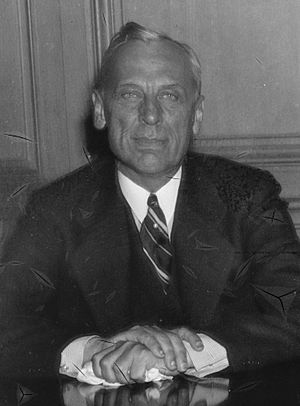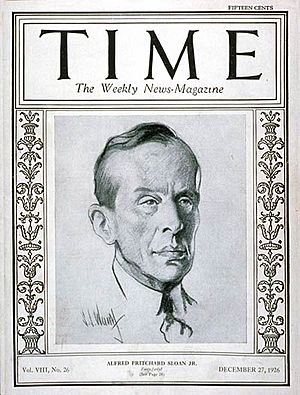Alfred P. Sloan facts for kids
Quick facts for kids
Alfred P. Sloan
|
|
|---|---|

Alfred P. Sloan in 1937
|
|
| Born |
Alfred Pritchard Sloan Jr.
May 23, 1875 |
| Died | February 17, 1966 (aged 90) Memorial Sloan Kettering Cancer Center, New York City
|
| Education | Brooklyn Polytechnic Institute, Massachusetts Institute of Technology |
| Known for | President & CEO of General Motors |
| Spouse(s) | Irene Jackson |
Alfred Pritchard Sloan Jr. (born May 23, 1875 – died February 17, 1966) was an important American business leader. He worked in the automotive industry, which makes cars. He was the president, chairman, and CEO of General Motors, a very large car company.
Sloan helped General Motors (GM) grow a lot from the 1920s to the 1950s. During these years, new ideas like changing car models every year, creating different car brands, and designing cars with style became popular. These changes helped the car industry grow and changed how people lived all over the world.
Sloan wrote a book about his time at GM called My Years with General Motors. People remember Sloan for his great achievements and for his generous donations.
Contents
Life and Career
Alfred Sloan was born in New Haven, Connecticut. He studied electrical engineering at the Massachusetts Institute of Technology (MIT), graduating in 1895. In 1898, he married Irene Jackson. They did not have children.
In 1899, Sloan became the president and owner of Hyatt Roller Bearing. This company made bearings for machines. Oldsmobile was their first car company customer. In 1916, Hyatt joined other companies to form United Motors Company. This company soon became part of General Motors.
Sloan quickly moved up at GM. He became vice-president, then president in 1923, and chairman of the board in 1937. In 1934, he started the Alfred P. Sloan Foundation, which gives money to good causes.
Sloan is famous for starting the idea of changing car styles every year. This led to the idea of "planned obsolescence". This means products are designed to be replaced after a certain time. He also created a pricing system for GM's car brands. From lowest to highest price, they were Chevrolet, Pontiac, Oldsmobile, Buick, and Cadillac. This way, GM cars did not compete with each other. Buyers could stay with GM as they got older and could afford more expensive cars.
In 1919, Sloan helped create the General Motors Acceptance Corporation (GMAC). This company helped people get loans to buy cars. Before this, people had to save for years to buy a car. These ideas helped GM become the biggest car company in the world by the early 1930s. GM kept this top spot for over 70 years.
In the 1930s, GM faced challenges from workers who wanted to form unions. Sloan did not like violence. Instead, he used spies to watch union activities. However, when workers held the huge Flint sit-down strike in 1936, spying did not work. The strike was successful and helped the United Auto Workers (UAW) union become the main group representing GM workers.
Sloan also supported education. In 1931, the first university program for business leaders, called the Sloan Fellows, started at MIT. In 1952, the Alfred P. Sloan School of Management was named after him. It is one of the best business schools in the world. His name is also on the Sloan-Kettering Institute and Cancer Center in New York, which helps fight cancer.
The Alfred P. Sloan Museum in Flint, Michigan, shows the history of cars. Sloan retired as GM chairman in 1956. His book, My Years with General Motors, was published in 1964. Alfred Sloan died in 1966.
Philanthropy
The Alfred P. Sloan Foundation is a non-profit group started by Sloan in 1934. This foundation supports science, technology, and education. It also helps improve people's lives and the economy. In 2014, the foundation had assets worth about $1.876 billion.
The Sloan Foundation helped fund a 1956 cartoon called Yankee Dood It. This cartoon promoted the idea of making many products quickly. The foundation also funded short films that showed the good things about capitalism and the American way of life.
Sloan also supported groups that were critical of the New Deal. The New Deal was a series of programs started by President Franklin D. Roosevelt to help the country during the Great Depression.
The Sloan Foundation has given large grants to the Wikimedia Foundation, which runs Wikipedia.
Criticism
Focus on Profit
Some people have said that Sloan built a company that focused too much on rules and systems. They believe it did not focus enough on people or values. This way of managing might have made it hard for GM to change later on. This could be one reason for GM's problems in the 1980s, 1990s, and 2000s.
Sloan himself knew that staying at the top would be hard for GM. He believed that smart management could handle future challenges. He thought GM's way of doing things would help it meet competition and changing customer demands. However, some people, like Peter Drucker, felt that Sloan relied too much on logic alone.
Accounting System Issues
Sloan's way of managing money at GM has also been criticized. Some say it made the company value products in storage (inventory) the same as cash. This meant there was no penalty for having too much inventory. Having too much inventory can be bad for a company because it costs money to store.
However, this criticism is made looking back in time. When Sloan was working, it was hard to get parts quickly. So, having extra inventory was important to make sure cars could be built. The car industry was growing very fast, and losing sales because of a lack of parts was a bigger worry than storing too many. Sloan's system was seen as a big improvement at the time.
Operations in Nazi Germany
Before and during World War II, General Motors had factories in Germany, like Opel. These factories produced vehicles and other items for the German government. In 1938, a GM executive, James D. Mooney, received an award from the German government.
Some historians say that Germany's war efforts were helped by technology from GM. Sloan said that Opel was taken over by the German government during the war. However, others say that GM-appointed leaders remained in charge. Sloan believed that GM had to act as a "German organization" and could not simply close its factories there. He said that how the German government ran the country was not GM's business.
Post-war
After World War II, many experts thought the economy would struggle. They believed that without a lot of government spending, the country would go back to the Great Depression.
But Sloan thought differently. He predicted that people would have money saved up and would want to buy many new things. He believed this would lead to a big economic boom. He was right. Even though the government cut spending, the economy grew a lot. This became one of the best times for economic growth in American history.
See also
 In Spanish: Alfred Pritchard Sloan para niños
In Spanish: Alfred Pritchard Sloan para niños
- The Alfred P. Sloan Prize - given to films about science and technology by the Alfred P. Sloan Foundation at the Sundance Film Festival.
- Sloan was a member of the Crusaders, a group that wanted to end Prohibition (the ban on alcohol) in the U.S.
- List of covers of Time magazine (1920s) - December 27, 1926



